Baguette diamonds have maintained their timeless elegance and classic charm since their heyday during the Art Deco era. They exude a sleek sophistication, especially when incorporated as side stones in engagement rings and wedding bands. If you’re wondering what exactly a baguette diamond is, you’re in the right place.
In this article, we will delve into all the essential details about baguette diamonds, exploring their versatility and unique characteristics. Keep reading to uncover the fascinating world of baguette diamonds.
DESIGN YOUR OWN ENGAGEMENT RING: START WITH A SETTING OR START WITH A DIAMOND. IT’S REALLY UP TO YOU!
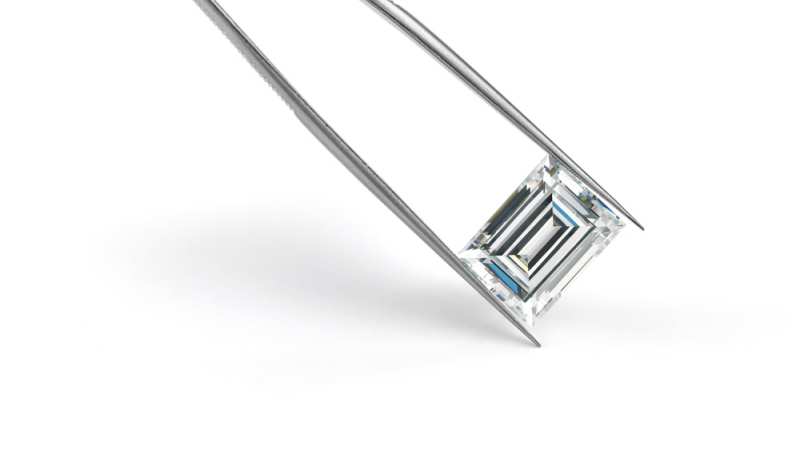
What Is A Baguette-Cut Diamond?
A baguette diamond refers to both the shape and cut of a diamond. To qualify as a baguette, a diamond must have a thin and elongated rectangular shape. Square-shaped baguettes are rare, with most falling into a length-to-width ratio of 3:1.
As a member of the step-cut diamond family, which includes Asscher and emerald cuts, baguettes differ in one significant aspect—their corners are perfectly square. With 14 facets, baguette diamonds offer exceptional clarity, subtle sparkle, and brilliance, making them ideal for use as side stones.
Unlike other cuts that prioritize brilliance, baguettes produce a clear reflection due to their long and narrow facets. Step-cuts are often compared to a hall of mirrors for their distinctive appearance. The minimal number of facets and clean lines in baguettes create a prismatic reflection that enhances the centerpiece of a ring with light and clarity.
Baguettes typically come in straight or tapered shapes. Straight baguettes have straight edges, forming a rectangular shape, while tapered baguettes feature edges that slope inward on the length sides, resulting in one shorter width edge resembling a narrowed trapezoid.
Baguette diamonds are commonly used in smaller carat weights and are rarely used as center stones in rings. This preference ensures higher quality, as the fewer facets provide less sparkle and make imperfections more apparent. Therefore, it’s crucial to select a higher quality gemstone and match its color with the center gemstone.
It’s important to note that baguettes, despite often being used as smaller side stones, are more susceptible to damage due to their square corners and larger surface area. Opting for secure settings like channel or bezel settings can help protect these gems from potential damage.

History Of Baguette-Cut Diamonds
The origins of modern baguette diamonds can be traced back to a cut known as “hogback” in the 16th century. This cut featured an elongated table and was often used for creating jeweled letters and diamond monograms. In 1912, renowned jewelry designer Cartier reintroduced the baguette cutting method, which gained significant popularity during the Art Deco period. The Art Deco movement’s emphasis on minimalist, geometric shapes, and clean lines greatly influenced the appeal of baguette diamonds.
The streamlined form and fewer facets of baguette diamonds contribute to their lightweight nature and unique individuality. In the 1920s, baguette diamonds often took center stage in rings and other jewelry pieces, with multiple gemstones arranged in precisely patterned designs. Today, baguettes are celebrated for their vintage yet modern look and versatility.
When it comes to the 4C’s of baguette-cut diamonds:
- Cut: Baguette-cut diamonds have a long and slender rectangular shape, typically with a length-to-width ratio of 5:1. As members of the step-cut family, they feature 14 facets in the form of straight lines and perfectly square corners. The focus of the cut is on clarity and depth of light reflection, rather than brilliance and fire. Baguettes come in two shapes: straight and tapered edges.
- Carat: Baguette diamonds are usually used as side and accent stones rather than center stones, resulting in smaller carat weights. This smaller size ensures better quality by facilitating the cutting process around imperfections. Baguettes are often purchased in sets to maintain a balanced appearance on either side of the centerpiece, and the total carat weight (TCW) is indicated when buying them in bulk.
- Color: Due to their shallow cut, baguette diamonds tend to reveal more color compared to round brilliant cut diamonds. To achieve a colorless appearance when viewed face-up, it is recommended to choose a G or H color grade as the lowest. Since baguettes are frequently used as side stones, it’s essential to match their color with the center stone to maintain a cohesive look.
- Clarity: Clarity is crucial when considering baguette diamonds, given their low number of facets and the clear light reflection they produce. Even minor flaws become more noticeable due to the limited facets. Therefore, opting for a higher clarity grade, such as VS2 or higher, is important to ensure an eye-clean appearance. Despite being smaller side stones, their size does not diminish the visibility of flaws.
By considering these factors, you can make an informed decision when selecting a baguette-cut diamond that meets your preferences and requirements.
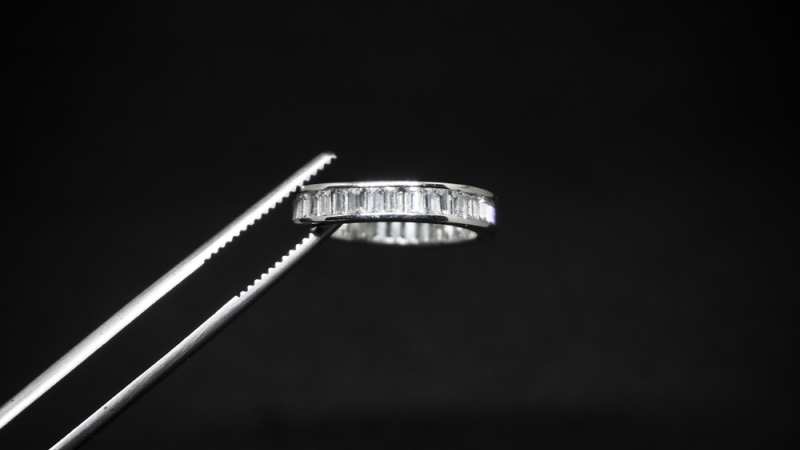
Baguette-Cut Diamond Prices
Baguette diamonds are typically less expensive compared to other diamond shapes due to their lower carat weight. While there may be some variation in price based on quality, the price range for baguette diamonds is generally narrower since they are produced within specific size and quality parameters to fulfill their intended purpose.
While larger size and higher quality baguette diamonds will command a higher price, the price increase is not as exponential as seen with larger round or fancy-shaped diamonds.
When choosing an ideal baguette-cut diamond, the criteria for cut, clarity, and color are relatively straightforward. Aim for higher grades in these aspects to achieve a beautiful and visually appealing diamond with excellent clarity.
However, when it comes to baguette diamonds used as side stones, there is a more extensive consideration regarding their matching qualities to achieve an ideal look. Since baguettes are often sold in multiples, it is crucial that they closely resemble each other in all aspects. This stone-to-stone matching creates a symmetrical and harmonious appearance for your ring.
In addition to matching cut, color, and clarity between baguette diamonds, their dimensions should also be very similar. The surface area dimensions of the baguettes should match rather than focusing solely on carat weight.
Another important aspect is ensuring that the baguette diamonds match well with the center stone of the ring. Consulting with a professional jeweler can help you determine the most complementary grades to look for in baguette diamonds based on the cut, color, and clarity of your center stone.
As a general rule of thumb, it is essential to ensure that the baguette diamonds match in color and preferably have close clarity grades to the center gemstone. It is recommended to view them in person, side by side, before making a purchase to assess their compatibility and overall appearance.
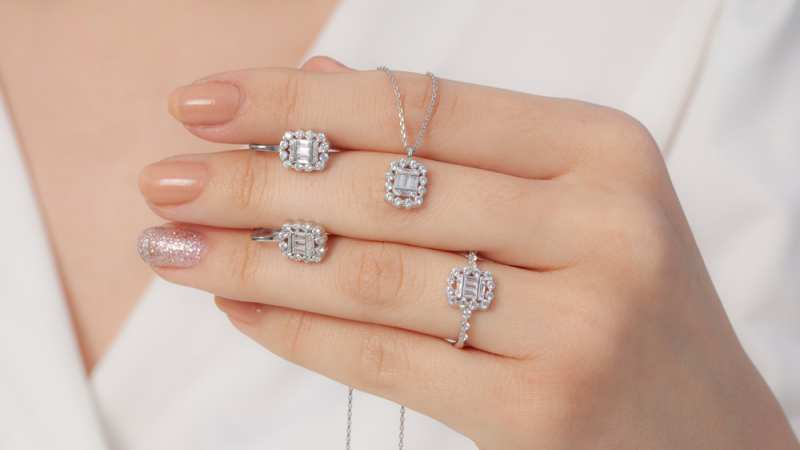
Baguette-Cut Diamond Engagement Ring Settings
Baguette diamonds are an excellent choice for incorporating as side stones in a three-stone ring setting, creating a stunning engagement ring that highlights the centerpiece. Typically, baguette-cut diamonds are set horizontally on each side of the center stone, drawing attention to its beauty. Another common arrangement is using tapered baguette diamonds in a setting where the narrower end points away from the center gemstone, adding extra brilliance to the ring.
Three-stone ring designs often feature tapered baguette-cut diamonds alongside an emerald cut diamond. This combination showcases perfectly matched step-cut diamonds in baguette and emerald cuts, creating a harmonious and elegant look.
For a sophisticated and clean appearance, baguette diamonds are an ideal choice as accent stones in channel settings. The channel setting involves setting small diamonds into the metal band leading up to the center stone, resulting in a refined and polished aesthetic.
Baguette diamonds also lend themselves well to vintage ring settings. When paired with round diamonds, baguettes add variety and enhance the overall design, elevating the ring to a new level of beauty and charm.
If you’re considering eternity bands, baguette diamonds are a great option. A row of straight baguette-cut diamonds set in a channel creates a sleek and elegant look, symbolizing an unending circle of love.
For those seeking a standout diamond ring, the ballerina halo setting offers a unique and captivating choice. In this setting, a string of baguette gems is aligned and points outward in a radiant shape, creating a dazzling display of brilliance and glamour.
Incorporating baguette diamonds into these various ring settings allows for creative and versatile designs that accentuate the centerpiece while adding a touch of sophistication and individuality to the overall aesthetic.
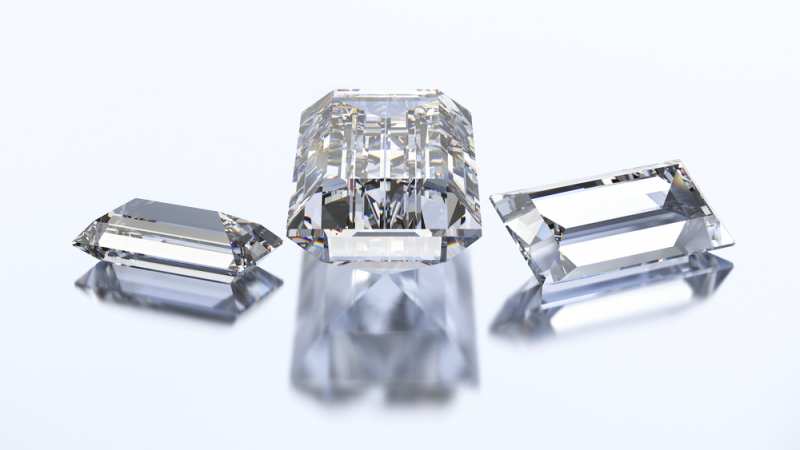
Other Step-Cut Diamonds
Step-cut diamonds are characterized by their rectangular or square shape with facets arranged in parallel lines on all four sides. The facets of step-cut diamonds are more prominent than those of round brilliant cut diamonds, creating a distinctive step-like appearance, hence the name.
When step-cut diamonds are discussed, they are often compared to a “hall of mirrors” due to the repetitive reflection pattern seen from the large top surface of the stone.
In addition to baguette diamonds, there are two other members of the step-cut family: emerald-cut and Asscher-cut diamonds.
Emerald-Cut Diamonds
The emerald cut is the most well-known member of the step-cut family. It takes its name from the gem it was originally created for, the emerald. An emerald-cut diamond is characterized by its long, rectangular shape and truncated corners that give it an octagonal appearance.
The emerald cut is often admired for its sophisticated look and clean lines.
Asscher-Cut Diamonds
The Asscher cut is structurally identical to the emerald cut but features a square shape. It showcases large facets and a high crown, creating a distinctive windmill-like pattern.
With its deeper trimmed corners, Asscher-cut diamonds also exhibit an octagonal appearance, but they typically have more brilliance than emerald-cut diamonds due to their greater depth.
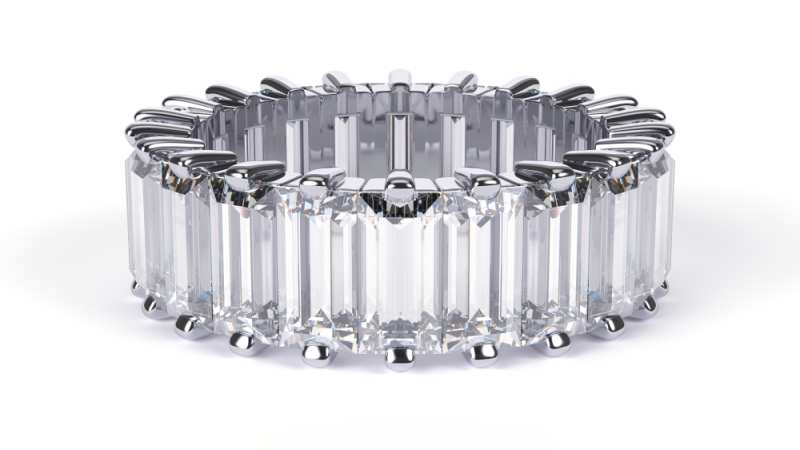
Conclusion
What exactly is a baguette diamond?
Baguette diamonds are a type of step-cut diamond that belongs to the step-cut diamond family. Unlike other step-cut diamonds, baguettes have fewer facets, which gives them a cleaner and more streamlined appearance. They are often used as side stones in rings to enhance the overall beauty of the center stone.
When it comes to jewelry, baguette-cut diamonds add a timeless and elegant touch. Their versatility as side stones makes them a perfect choice for enhancing the beauty of engagement rings and other jewelry pieces.


